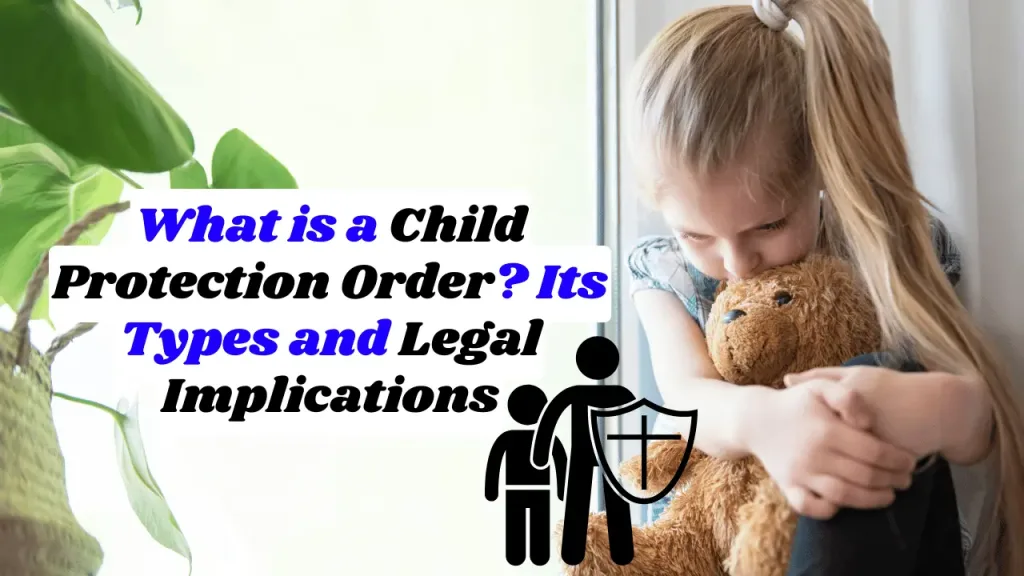What is a Child Protection Order? Its Types and Legal Implications
In the UK, a child is referred to social services every 49 seconds, with over 50,000 children currently under protection plans due to abuse or neglect. Child Protection Orders are crucial legal tools that help safeguard children at risk, offering both immediate and long-term protection. These orders can be complex and daunting for parents and caregivers, making it essential to understand the types, legal grounds, and implications.
This includes types, the legal process, and parental rights. We also explore the relationship between these orders and criminal proceedings, supported by expert insights and statistics on child safety. With references to key UK legal codes, this resource ensures you have a comprehensive understanding of the law.
Table of Contents
What is a Child Protection Order?
A Child Protection Order (CPO) is a legal mechanism in the UK used by courts to take care of children who may be at risk of harm or neglect. These orders are granted when a child is believed to be in immediate danger or in circumstances that warrant intervention for their safety. Local authorities, usually working with social services, can seek these orders to protect the child’s welfare by temporarily removing them from harmful environments or placing them under official supervision.

Types of Child Protection Orders
In the UK, child protection orders are essential tools to ensure the safety and welfare of children at risk. These orders are regulated under several legislative frameworks, including the Children Act 1989. Here’s a breakdown of the common types:
Emergency Protection Orders (EPOs)
An Emergency Protection Order (EPO) allows immediate action when a child faces imminent danger. Courts issue an EPO for up to 8 days, extendable by another 7 days if necessary. It grants local authorities the power to remove the child from the current environment if they believe significant harm will occur without urgent intervention. No prior notice to parents is required if the child’s safety demands immediate action.
- Legal Reference: Section 44 of the Children Act 1989.
- Statistics: In 2023, over 5,000 EPOs were issued in England and Wales, highlighting their critical role in urgent situations (UK Government Statistics).
Child Assessment Orders (CAOs)
A Child Assessment Order (CAO) mandates a professional evaluation of a child’s welfare when there are concerns but insufficient evidence for an EPO. Typically lasting 7 days, with a possible extension for another 7 days, CAOs enable local authorities to gather necessary information to make informed decisions.
- Legal Reference: Section 43 of the Children Act 1989.
Interim Care Orders (ICOs)
An Interim Care Order (ICO) temporarily transfers care responsibilities to the local authority while the court determines the next steps. It can last up to 8 weeks initially and be extended in 28-day increments. ICOs are issued when evidence suggests a significant risk of harm if the child remains in their current care.
- Legal Reference: Section 38 of the Children Act 1989.
Care Orders
A Care Order grants long-term responsibility of a child to the local authority, often until the child turns 18 unless revoked earlier. The court only grants a Care Order when convinced that the child faces significant harm in their current living conditions. Children under Care Orders may live in foster care or a children’s home.
- Legal Reference: Section 31 of the Children Act 1989.
Related Articles For You:
How to Successfully Discharge a Care Order in the UK? Your Essential Guide
Valid Reasons to Stop Child Access (Contact) with the Other Parent in the UK
Supervision Orders
A Supervision Order does not remove a child from their home but requires oversight by a social worker for up to 12 months, extendable for another 6 months. It is applied when there is risk but not enough to justify a Care Order, aiming to support families while addressing concerns.
- Legal Reference: Section 35 of the Children Act 1989.
Grounds for Child Protection Orders
Courts consider multiple factors when deciding to grant a child protection order:
- Risk of Harm: Physical, emotional, or sexual abuse and neglect are primary concerns. Courts assess whether the child’s current environment poses immediate or potential harm.
- Child’s Best Interests: Legal decisions are centered around the child’s welfare, taking into account educational needs, emotional stability, and cultural background.
- Parental Capability: Evaluating the parent’s or caregiver’s ability to provide a safe environment. If doubts exist, courts may order parenting assessments.
- Child’s Wishes: Depending on the child’s age and understanding, their views may influence the court’s decision, though welfare remains the priority.
- Statistics: Over 70% of child protection orders are based on concerns of neglect and exposure to domestic violence, highlighting these factors’ prominence (National Society for the Prevention of Cruelty to Children).
The Child Protection Order Process
Starting a Child Protection Case
Concerns about a child’s welfare can be raised by teachers, healthcare professionals, family members, or social services. Once reported, local authorities initiate an assessment.
Assessment and Investigation
Social services conduct a risk assessment, involving conversations with the child, family, and relevant professionals. If the risk is significant, a formal investigation follows, possibly leading to court proceedings.
Court Proceedings
The local authority presents evidence before a family court, which assesses the need for protective measures. The Children and Family Court Advisory and Support Service (CAFCASS) plays a crucial advisory role, providing independent assessments of what is in the child’s best interest.
Obtaining and Challenging Child Protection Orders
Obtaining a Child Protection Order
Local authorities or police initiate the process based on substantial evidence of risk. The court’s decision focuses on the child’s safety and wellbeing.
Appealing a Child Protection Order
Parents have the right to appeal within 21 days if they disagree with an order. The appeal is reviewed by a higher court, examining the evidence’s necessity and proportionality.
Duration of Child Protection Orders
Each type of order has a set duration:
- EPO: Up to 8 days, extendable by 7.
- CAO: 7 days, extendable by another 7.
- ICO: 8 weeks, extendable in 28-day periods.
- Care Order: Until 18 years of age unless revoked.
- Supervision Order: 12 months, extendable by 6 months.
Breaching a Child Protection Order
Non-compliance is treated seriously. Breaches may result in fines, imprisonment, or stricter conditions.
Parental Rights and Child Protection Orders
Parental rights are affected when a protection order is in place. With Care or Interim Care Orders, parental responsibility is shared with local authorities, limiting the parent’s decision-making power. Contact with the child may be restricted and subject to conditions.
Parents seeking to regain full parental responsibility can apply for discharge if they demonstrate the capacity to provide a safe environment.
Child Protection Orders and Criminal Proceedings
When child protection concerns intersect with allegations of abuse, criminal investigations may run alongside child protection cases. Evidence from these investigations can influence court decisions, though child protection cases prioritize the child’s welfare over criminal outcomes.
Legal advice is crucial when managing cases involving both child protection and criminal proceedings.
Conclusion
Child protection orders are vital in safeguarding vulnerable children from harm or neglect. Understanding the types of orders, legal grounds, and procedural nuances helps ensure the child’s welfare is upheld while respecting parental rights. For those involved in such cases, seeking expert legal advice is essential to sort through the legal complexities and work towards the best possible outcome for the child.
References
About the Author

Sarah Klein, JD, is a former family law attorney with over a decade of courtroom and mediation experience. She has represented clients in divorce, custody cases, adoption, Alimony, and domestic violence cases across multiple U.S. jurisdictions.
At All About Lawyer, Sarah now uses her deep legal background to create easy-to-understand guides that help families navigate the legal system with clarity and confidence.
Every article is based on her real-world legal experience and reviewed to reflect current laws.
Read more about Sarah
